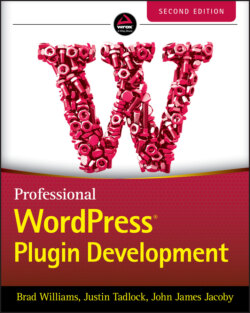Читать книгу Professional WordPress Plugin Development - Brad Williams - Страница 100
Adding a Section to an Existing Page
ОглавлениеYour previous plugin was adding a whole new section and its input field on a stand‐alone page. You now modify it to insert this content into WordPress’ Privacy Settings page.
<?php $args = array( 'type' => 'string', 'sanitize_callback' => 'pdev_plugin_validate_options', 'default' => NULL ); register_setting( 'reading', 'pdev_plugin_options', $args ); add_settings_section( 'pdev_plugin_options', 'PDEV Plugin Settings', 'pdev_plugin_section_text', 'reading' ); add_settings_field( 'pdev_plugin_text_string', 'Your Name', 'pdev_plugin_setting_name', 'reading', 'pdev_plugin_options' ); ?>
Notice that the first parameter passed in the register_setting() function call is set to reading. This function now adds your custom section into the reading section, which is located within the Reading Settings page, as shown in Figure 3‐6. Replace all reading instances with media, and your section will be appended at the end of the Media Settings page.
FIGURE 3‐6: Section appended
You still need to whitelist this setting, with register_setting(). Omitting this step would make WordPress ignore the setting when submitting the form.
